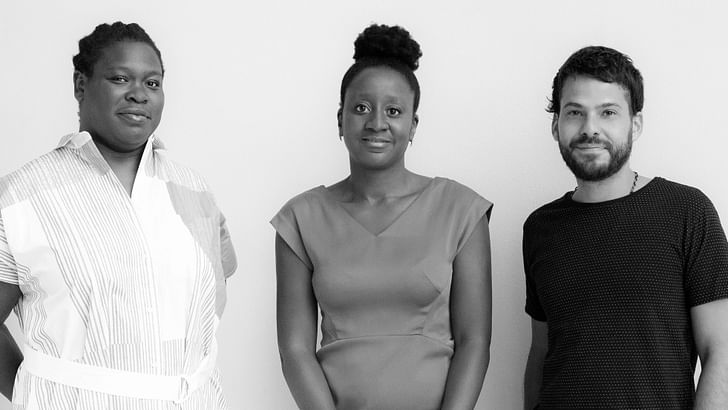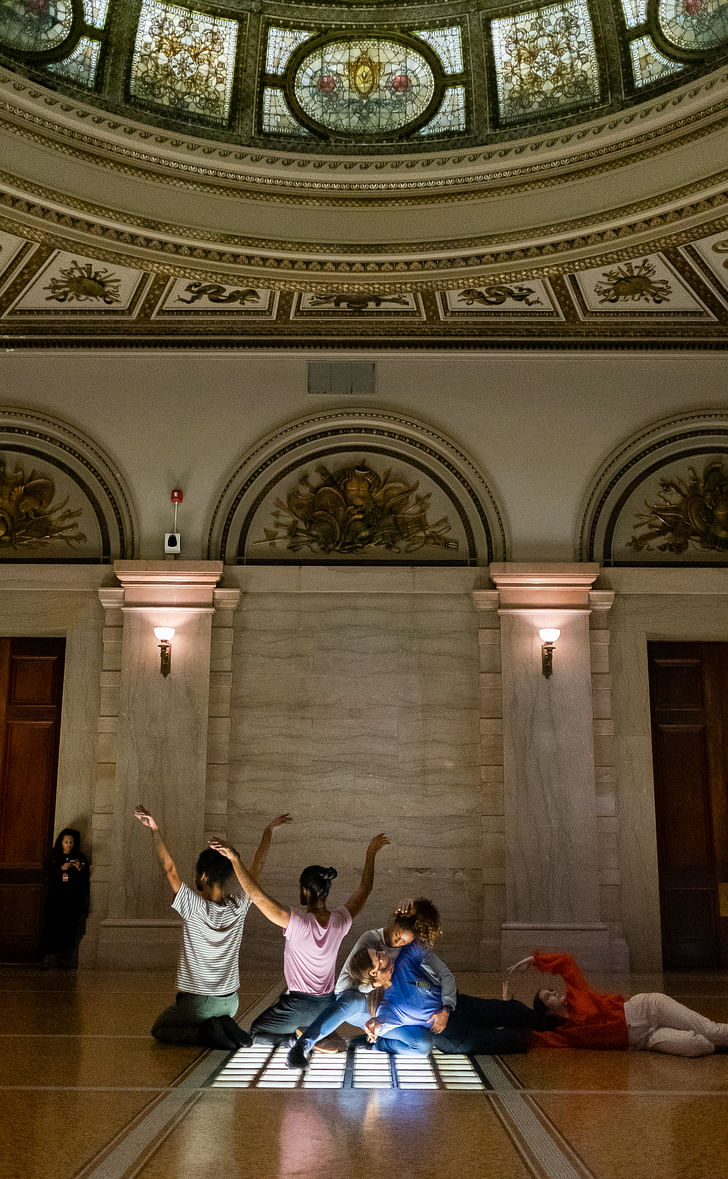

Programming an international architecture biennial is no easy task, much less so when the goal is to create a program that seeks to recast prevailing narratives surrounding lived experiences of the built environment.
For the 2019 run of the Chicago Architecture Biennial (CAB), artistic director Yesomi Umolu is attempting to do just that, however. By re-positioning, documenting, and indexing spaces, their materialities, and the narratives embodied by their existences, Umolu seeks to cast these elements as active participants in our society, as phenomena that transcend aesthetics, and instead embrace a multi-faceted and sometimes deeply problematic nature.
Archinect caught up with Umolu to discuss the goals of the biennial's curatorial output, design practices that "reflect upon a broad set of spatial conditions and make space through a variety of means," and how the ways we look at buildings might be challenged by these broadly based approaches.
Contrary to previous iterations of the Chicago Architecture Biennial, this year’s program seems to pursue a more holistic view of the built environment that transcends what might be normatively considered “architecture.” This emphasis is also visible in many of the exhibitions you have curated at the Logan Center for the Arts previously—What is the relationship between “architecture” and “spatial practice,” and how have these concepts informed the curatorial regime for CAB?
This edition of the Biennial embraces architecture as an expansive practice that crosses disciplines and scales. When my co-curators—Paulo Tavares and Sepake Angiama—and I began working on the Biennial together, our central operating premise was not to set a thesis or a question and then subsequently look for practices that responded to this, but rather to begin a series of conversations in Chicago and elsewhere on architecture and the built environment today. Through this research-led process, we engaged a wide range of individuals and collectives, and listened as a set of urgencies emerged. Some of these contributors are architects, but some of them are “spatial practitioners” i.e. practices that reflect upon a broad set of spatial conditions and make space through a variety of means.
In our view, MSTC is actively making space in the city and reframing the relationship between the built environment and marginalised communities. We see this work as being extremely significant to the practice and the profession of architecture.
For us, we see the work of Brazilan social movement as one such practice. MSTC use the practice of occupying vacant buildings in downtown Sao Paulo as a means of asserting housing as a basic right. In our view, MSTC is actively making space in the city and reframing the relationship between the built environment and marginalised communities. We see this work as being extremely significant to the practice and the profession of architecture. This is true to the extent that MSTC has engaged the architecture profession in a variety of ways throughout its lifetime, from inviting architects and designers to work with them on rehabilitating spaces, to being the subject of numerous studies from architecture students and researchers. Their presentation at the Biennial, which was conceived in collaboration with the architecture school Escola de Cidade and art and architecture collective O Group Inteiro, extends their direct engagement with and relevance to the field of architecture.

How has your education as an architect influenced your career as a curator? Have you had to un-learn some of that training to push into the unique curatorial agenda your work currently pursues?
My training as an architect and my career as a curator of contemporary art are inextricably linked. Both practices taught me different ways of thinking about cultural production and of intervening in public space, and both perspectives were invaluable in creating this edition of the Chicago Architecture Biennial.
In a project such as this, where work is being done to decolonize knowledge and to reveal the built environment's complicity in acts of settler colonialism, there has to be a simultaneous unraveling of our received language of looking and being in the world. I would like to think this project is one of many examples in the Biennial where visitors from all walks of life are asked to reframe their ways looking.
The group ArchiteXX and others have voiced criticism over CAB receiving funding from fossil fuel company BP, and have gone as far as “boycotting” affiliation with the event in protest; In light of recent events with the Whitney Biennial, and other arts institutions, how did you navigate this situation as the artistic director for the Chicago Architecture Biennial?
I respect ArchiteXX’s right to free expression and dissent. As a not-for-profit, the Chicago Architecture Biennial has found support across a number of sectors, including philanthropic foundations; local, national and international government-based arts and cultural funds; private individuals; and businesses of varying scales. These diverse sources are fundamental to the viability of this emergent organization, which produces exhibitions, programs and learning initiatives that remain free and open to the public. Understanding the immense value the Biennial brings to the city of Chicago and its communities, this edition of the Biennial aims to amplify voices and histories that the curatorial team believes are crucial to the conversation on where we see the future of our societies and environments.
The 2019 Chicago Architecture Biennial addresses questions on architecture and the built environment that we felt were most compelling and urgent to our world today. Energy, land-use, and the changing climate are central to some of the major challenges facing our natural and built environments. As such, a number of projects, including The Museum of Oil by Territorial Agency, encourage alternative designs and relationships between land, nature, and society. These projects were developed through close collaboration between the curatorial team and contributors, and are wholly independent of the Biennial’s sponsorship. Our hope is that this edition serves as a platform to collectively reflect upon the pressing issues of our time, bringing the diverse perspectives of architects, urbanists, social movements and everyday citizens to the fore.
What is your favorite building, space, or site in Chicago, and why?
The Chicago Cultural Center, which is the Biennial’s main venue, is a building that has been important and influential for me in many ways.

My training as an architect and my career as a curator of contemporary art are inextricably linked. Both practices taught me different ways of thinking about cultural production and of intervening in public space, and both perspectives were invaluable in creating this edition of the Chicago Architecture Biennial.
Several critics have remarked on the relatively academic and text-heavy focus of the exhibition materials presented in some CAB exhibitions; I’m curious what you think this means for the longevity of the ideas and events presented by CAB, and what you think this criticism says about the ability of architectural audiences to really grapple with issues that don’t immediately involve “eye-candy.”
Through my curatorial work I have come to understand that any presentation of artistic and cultural work should provide different levels of engagement. I think that with a biennial such as the Chicago Architecture Biennial, which is hosted in a major public building in the center of the city, and which welcomes thousands of visitors with each edition from cultural practitioners, architectural professionals, tourists, academics, students, schoolchildren to everyday citizens, it is an important curatorial gesture not to presuppose an audience’s capacity for engagement. It is also important that the practices contributing to the Biennial be allowed the freedom to create work that communicates in a myriad of ways.
In the Biennial, visitors will find projects that range from large scale architectural installations such as those by MASS Design Group or Sweet Water Foundation, to immersive mixed media-based research projects such as those by Raul Mehotra Architects, Wolff Architects, and Cohabitation Strategies/Urban Front, to gathering spaces such as those by Construct Lab and Adrian Blackwell. The aim is to create a holistic experience that offers everything from moments of pure aesthetic pleasure to the mindful contemplation of deep topics ranging from housing rights, land sovereignty, urban violence to making spaces for communal gathering. Many projects offer both—something that can be engaged with quickly, visually, or interactively, and an element that offers an in-depth experience.
I think that with a biennial such as the Chicago Architecture Biennial, which is hosted in a major public building in the center of the city, and which welcomes thousands of visitors with each edition from cultural practitioners, architectural professionals, tourists, academics, students, schoolchildren to everyday citizens, it is an important curatorial gesture not to presuppose an audience’s capacity for engagement.
An important example of this is the Settler Colonial City Project produced in collaboration with the American Indian Center, which uses interpretive materials (mimicking the didactic panels that one already finds throughout the building) to engage in the process of decolonizing the Chicago Cultural Center. There are visual elements of the project that point to the hidden histories of the building’s architecture and site, and this is augmented by interpretive materials and publications that allow for a deeper dive into these histories. In a project such as this, where work is being done to decolonize knowledge and to reveal the built environment's complicity in acts of settler colonialism, there has to be a simultaneous unraveling of our received language of looking and being in the world. I would like to think this project is one of many examples in the Biennial where visitors from all walks of life are asked to reframe their ways looking.
Antonio is a Los Angeles-based writer, designer, and preservationist. He completed the M.Arch I and Master of Preservation Studies programs at Tulane University in 2014, and earned a Bachelor of Arts in Architecture from Washington University in St. Louis in 2010. Antonio has written extensively ...
No Comments
Block this user
Are you sure you want to block this user and hide all related comments throughout the site?
Archinect
This is your first comment on Archinect. Your comment will be visible once approved.